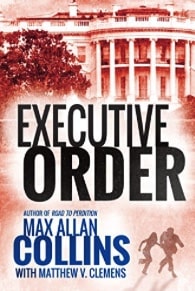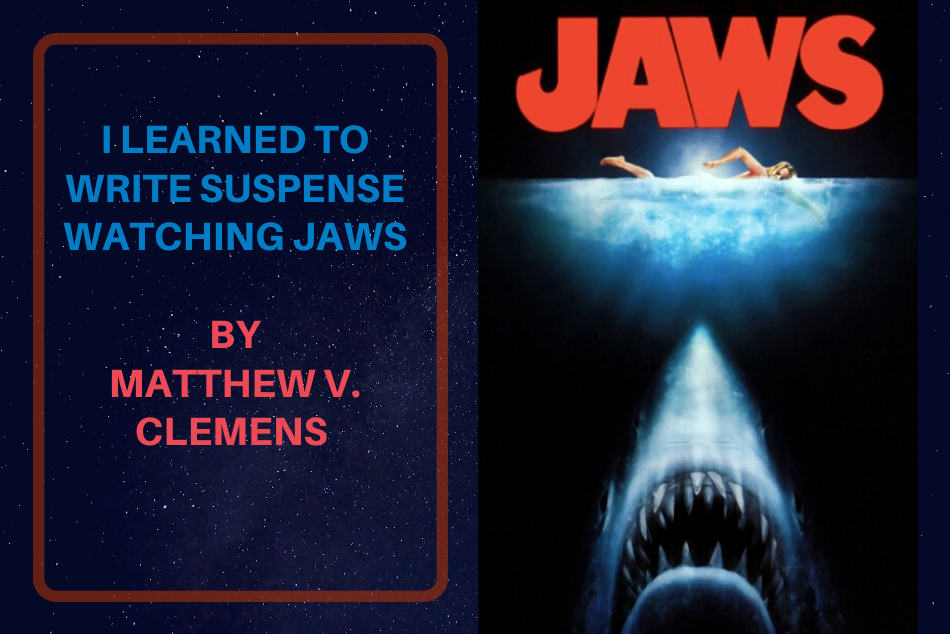I LEARNED TO WRITE SUSPENSE WATCHING JAWS
By
Matthew V. Clemens
Fast-paced, breakneck speed, unrelenting suspense — what readers are looking for in fiction, and how we want them to describe our books.
Director Steven Spielberg, from the screenplay by Peter Benchley and Carl Gottlieb, gave us the perfect lesson.
These filmmakers understand that unrelenting action wears out and bores the viewer the same as no action at all. Too much, too fast, too soon. Instead of bombarding the viewer, they pick and choose the spots to immerse the viewer, then release the pressure, then immerse them again.
Spielberg understands that the viewer needs a chance to breathe, to relax before the next adrenaline rush. They very clearly set a deliberate pace of thrill, rest, thrill. All the while, humanizing the characters so if they become a victim, they are not merely a cipher, but a three-dimensional character. Every victim, save the rowboat guy in the pond, has a name, some semblance of a life.
Jaws opens in the shark’s point of view during the credit sequence, planting the seed that the eerie theme means the monster is near.
Titles end, release suspense. Begin humanizing of characters. Young people at beach party, man flirts with woman, they run off. Young man asks her name as he chases her.
“Chrissy,” she says, still running.
That quick she’s not a cipher, she’s a human. A beautiful young girl who likes a boy, loves the water, is a good swimmer. We see all that before that first fateful tug.
Then comes Spielberg’s next lesson, she doesn’t scream. She grunts, gets pulled down, comes up, shivers, she’s already going into shock, but there’s no big scream, no blood in the water, just Chrissy terrified – suspense. Cut to drunk boy who never made it off the beach, release. Cut back to Chrissy, the shark hits again. Now she screams, the shark plays with her, kills her, takes her under, all while never showing the beast.
The buoy dings mournfully, and we don’t know for sure there’s a shark, but there’s damn sure a monster in the water.
Release the tension, leave the prologue, open Chapter One — meet Martin Brody, the everyman police chief on the island.
Throughout the film, the thread continues. Spielberg holds down us with suspense, lets us up, frequently with humor, holds us down again.
There is this constant back and forth as Spielberg expertly plays with us and our fears.
There’s the subplot of the mayor wanting the beaches open so Amity’s businesses will have the customers they need to survive the winter when no one is around. With the beach open, Brody scans the water looking for shadows, fins – his anxiety is ours.
A man throws a stick into the water and his dog chases it. A mother says to her son, “Alex Kintner, your hands are getting pruney,” but she lets him go back into the water for five more minutes. The suspense is building, then Spielberg has old man Harry come out of the water in his raggedy bathing cap and baggy trunks for the sole purpose of saying, “Chief, everyone knows about you, you don’t like the water.”
Shaking his head, Brody just says, “That’s some bad hat, Harry.” The suspense is broken again, but now we know Brody is afraid of water even when there isn’t a shark lurking.
Then Spielberg ratchets up the tension by having the owner call for the dog who has disappeared. As one, the audience thinks, no, not the dog. Turns out the dog is spared, but not Alex Kintner. There’s panic, blood, everyone is screaming, but we still haven’t seen the shark. Another lesson of Spielberg’s, he understands the imagined monster is scarier than the monster he could show us.
Scene after scene breaks down this way, the tightening of suspense and release coming faster now. The pace growing exponentially faster once Brody, Matt Hooper the shark expert, and Quint, the Ahab archetype, are on the Orca hunting the shark.
After their first encounter with the shark, we cut to them in the cabin, comparing scars, singing, joking. The tightening and releasing of the suspense as we get closer to the showdown. It’s like climbing a flight of stairs where the steps get progressively steeper and closer together the higher you go. At first you’re walking casually, but by the end you’re running to make it up to the next tiny step.
Back to the first encounter on the boat. This is one of the most famous scenes in cinema, Brody chumming, and saying, “I can go slow ahead. Why don’t you come down here and throw some of this shi…” and the shark breaks out of the water in its “I’m ready for my close-up, Mr. DeMille” moment.
Again, Spielberg doesn’t go for over the top histrionics. The cigarette doesn’t even leave Brody’s mouth. He just slowly backs up to the cabin door, where Quint is inside, and says, “You’re gonna need a bigger boat.”
The tension gets ratcheted up further as the battle with the shark begins in earnest. We’re past halfway, one hour and twenty-one minutes into the film, when the villain makes his first true appearance on the screen. The monster has been there all along, but never in his full-blown shark in your face way he is when Brody meets him.
Part of that was Spielberg working around a mechanical shark that brought with it mechanical issues, but that allowed the storytellers to use their gifts to draw us in without waving the shark in our faces.
Another example of the humanization of characters is Quint’s speech about the U.S.S. Indianapolis, he talks about his best friend Herbie Robinson from Cleveland, bosun’s mate, baseball player. Six words and we know the guy, Quint’s loss is our loss.
Pacing, making sure you’re not rushing, not dragging; humanizing characters so they’re more than just a name on a page. In the end, this film has taught me more about writing suspense than a lot of books.
So, if you want to write suspense, go watch Jaws, we can all learn from a good fish story now and then. And when you’re done, join the discussion on Facebook.
 Matthew Clemens Is a long-time co-conspirator with Max Allan Collins. The pair has collaborated on twenty-four novels, more than twenty short stories, several
Matthew Clemens Is a long-time co-conspirator with Max Allan Collins. The pair has collaborated on twenty-four novels, more than twenty short stories, several  comic books, four graphic novels, a computer game, and a dozen mystery jigsaw puzzles.
comic books, four graphic novels, a computer game, and a dozen mystery jigsaw puzzles.
Their last Thomas & Mercer thriller was EXECUTIVE ORDER.





